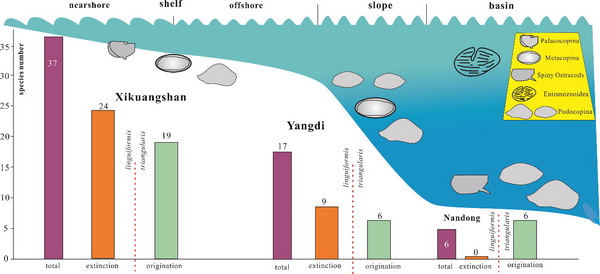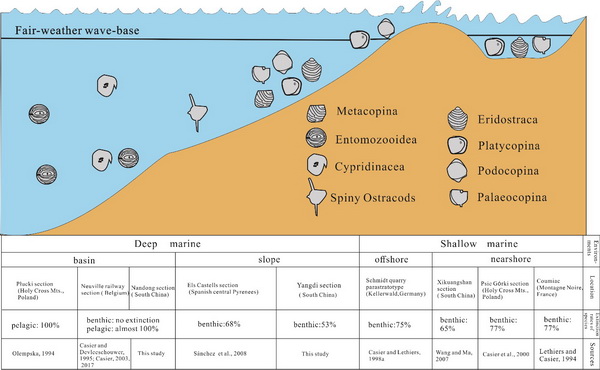The Late Devonian Frasnian-Famennian (F-F) mass extinction is traditionally known as one of the “Big Five” faunal crises during the Phanerozoic. Ostracods are microcrustacea that first appeared in the Ordovician (Cambrian?) and are still developing today. Ostracods offer special insights into the characteristics of the Devonian bio-environmental events. So far, it is still ambiguous that how benthic ostracods from shallow to deep waters responded to the crisis. Moreover, pelagic ostracods are relatively rare in the F-F transitional interval and their responses to the F-F event are not clear as well.
Recently, Dr. SONG Junjun from Nanjing Institute of Geology and Palaeontology, Chinese Academy of Sciences, together with her colleagues studied the Late Devonian ostracods from South China and Europe.
The study showed that ostracods in varied environments responded to the F-F event differently. Namely, from the carbonate platform, slope, to basinal settings, the extinction rate of benthic ostracods at the F-F transition decreased with increasing water depth. Nevertheless, the F-F event caused substantial loss among pelagic entomozooidea lineages.
The extinction pattern of benthic and pelagic ostracods in F-F event in South China is similar to the situation in Europe. But the extinction rates of benthic ostracods in shallow water and slope in Europe seems to be higher than that in the same situation in South China. The abundance and diversity of ostracods decreased and some species even disappeared in anoxic environments across the F-F boundary in South China, when there were rapid changes in the palaeotemperature of surface sea water.
Article information: Song, J. J., Huang, C. & Gong, Y. M. *, Response of Ostracods (Crustacea) to the Devonian F—F event: Evidence from the Yangdi and Nandong sections in Guangxi, South China. 2019, Global and Planetary Change 173: 109-120. https://doi.org/10.1016/j.gloplacha.2018.12.015

Extinction pattern of the Devonian F-F transitional ostracods from South China

Ostracod assemblages and extinction rates of benthic and pelagic species from shallow marine to deep marine setting in the F-F event.

The relationship between variations in the abundance and diversity of benthic ostracods and changes of the marine
